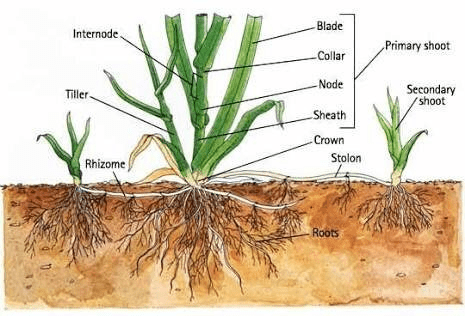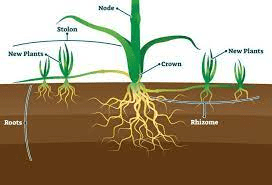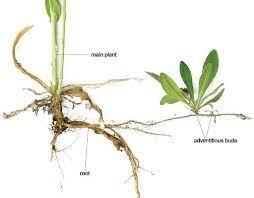Arrowroot adventitious roots refer to the specialized roots that develop from the nodes of the arrowroot plant, Maranta arundinacea. Unlike the primary roots that grow downward from the plant’s base, adventitious roots emerge from above-ground parts of the stem, such as the nodes or joints.
These roots play a crucial role in the propagation and spread of the arrowroot plant, aiding in its ability to establish new growth and colonize favorable habitats.
Maranta arundinacea, commonly known as arrowroot, is a tropical perennial herbaceous plant native to South America. It produces thick, fleshy rhizomes that store energy reserves and serve as a means of vegetative reproduction.
Adventitious roots emerge from these rhizomes, as well as from the nodes along the plant’s stems, enabling it to spread horizontally and colonize new areas of suitable soil.
The development of adventitious roots is often triggered by environmental factors such as soil moisture, temperature, and the presence of rooting hormones. In response to favorable conditions, the arrowroot plant produces specialized cells at the nodes, which differentiate into root primordia and ultimately give rise to adventitious roots.
These roots exhibit a high degree of plasticity, enabling the plant to adapt to diverse environmental conditions and optimize its nutrient uptake and anchorage.
Adventitious roots serve multiple functions within the arrowroot plant. They facilitate the absorption of water and nutrients from the surrounding soil, supplementing the function of primary roots and enhancing the plant’s overall capacity for resource acquisition.
Additionally, adventitious roots contribute to the stability of the plant, anchoring it firmly in the substrate and reducing the risk of dislodgment or damage due to environmental factors such as wind or erosion.
In agricultural settings, arrowroot adventitious roots play a significant role in the propagation of the plant. Farmers often utilize rhizome cuttings or divisions containing adventitious roots to establish new plantings, thereby accelerating the growth and expansion of arrowroot cultivation.
Furthermore, the presence of adventitious roots enhances the resilience and vigor of arrowroot plants, enabling them to thrive in a variety of soil types and environmental conditions.
Arrowroot adventitious roots exemplify the remarkable adaptability and reproductive strategies of the arrowroot plant. By leveraging these specialized roots, Maranta arundinacea is able to propagate effectively, establish new colonies, and persist in diverse ecosystems, contributing to its status as a valuable and resilient crop species.
The Economic Importance and Uses of Arrowroot Adventitious Roots

1. Arrowroot Flour Production: Arrowroot adventitious roots are crucial for producing arrowroot flour, a valuable ingredient in gluten-free baking and cooking. The roots are processed to extract the starch, which is then ground into a fine powder.
Arrowroot flour serves as a gluten-free alternative to wheat flour and cornstarch, catering to individuals with dietary restrictions or preferences.
2. Culinary Applications: Arrowroot adventitious roots play a significant role in various culinary applications. The extracted starch is used as a thickening agent in soups, sauces, gravies, and desserts, providing a smooth texture and glossy finish to dishes.
Additionally, arrowroot flour is prized for its neutral taste and ability to create light and airy baked goods such as cakes, cookies, and pastries.
3. Medicinal Uses: In traditional medicine systems, arrowroot adventitious roots are utilized for their medicinal properties. They are believed to have soothing effects on the digestive system and are often consumed to alleviate symptoms of gastrointestinal issues such as indigestion and diarrhea.
Arrowroot tea, brewed from the roots, is also used to promote overall digestive health and well-being.
4. Baby Care Products: Arrowroot adventitious roots are an essential ingredient in natural baby care products, particularly baby powders.
The fine powder derived from the roots is gentle on delicate skin and helps absorb excess moisture, preventing diaper rash and discomfort in infants. Arrowroot-based baby powders are preferred by parents seeking natural and gentle alternatives to talcum powder.
5. Cosmetic Formulations: Arrowroot adventitious roots are utilized in cosmetic formulations for their absorbent properties and skin-friendly nature. Arrowroot powder is commonly found in talc-free body powders, dry shampoos, and facial masks. It helps absorb excess oil, soothe irritation, and promote a smooth and matte complexion without clogging pores or causing sensitivity reactions.
6. Pharmaceutical Industry: Extracts derived from arrowroot adventitious roots are used in the pharmaceutical industry for their potential health benefits.
These extracts contain bioactive compounds with anti-inflammatory, antioxidant, and antimicrobial properties, making them valuable additions to herbal supplements, dietary capsules, and topical ointments.
7. Textile Sizing: Arrowroot starch, obtained from the adventitious roots, is utilized as a natural sizing agent in the textile industry. It helps improve the strength, smoothness, and crease resistance of fabrics during the manufacturing process, enhancing their quality and durability.
Arrowroot starch forms a transparent film on fabric fibers, providing a smooth and crisp finish without leaving behind residue.
8. Papermaking: Arrowroot starch is also employed in the papermaking process as a versatile additive for improving paper quality and performance. It enhances the strength, opacity, and printability of paper, resulting in sharper and more vibrant print results.
Arrowroot starch acts as a binder, improving fiber-to-fiber bonding and reducing dusting during paper production.
9. Animal Feed: By-products derived from arrowroot adventitious roots, such as spent roots and leftover plant material, can be used as nutritious additions to animal feed formulations.
These by-products contain valuable nutrients that support the health and growth of livestock, poultry, and pets. Incorporating arrowroot by-products into animal feed helps optimize nutrient utilization and reduce waste in agricultural systems.
10. Soil Amendment: Arrowroot by-products can be composted and recycled as organic soil amendments to improve soil fertility and structure. These by-products contribute organic matter, essential nutrients, and beneficial microorganisms to the soil, enhancing its ability to support plant growth and productivity.
Arrowroot by-products help increase soil moisture retention, improve soil aeration, and promote the proliferation of beneficial soil organisms.
11. Industrial Applications: Arrowroot adventitious roots find applications in various industrial processes, including the production of adhesives, glues, and coatings.
The starch extracted from the roots serves as a natural and eco-friendly alternative to synthetic additives, contributing to the sustainability and environmental friendliness of industrial operations.
12. Herbal Remedies: Arrowroot adventitious roots are used in herbal remedies and traditional medicine preparations for their therapeutic properties. They are believed to have anti-inflammatory, antispasmodic, and diuretic effects, making them useful in treating a wide range of ailments, including digestive disorders, respiratory infections, and skin conditions.
13. Dietary Supplements: Arrowroot extracts are sometimes incorporated into dietary supplements and herbal formulations for their potential health benefits. These extracts contain bioactive compounds that may support digestive health, immune function, and overall well-being.
Arrowroot supplements are available in various forms, including capsules, tablets, and tinctures, offering convenient options for individuals seeking to incorporate the health-promoting properties of arrowroot into their daily routines.
14. Energy Source: Arrowroot adventitious roots can be utilized as a source of energy through biofuel production. The starch content in the roots can be converted into bioethanol, a renewable and sustainable fuel alternative to fossil fuels.
Utilizing arrowroot as a feedstock for biofuel production helps reduce greenhouse gas emissions and dependence on non-renewable energy sources.
15. Horticulture: Arrowroot adventitious roots can be used in horticulture as a soil conditioner and mulch. When incorporated into garden beds or applied as mulch around plants, arrowroot by-products help improve soil structure, retain moisture, and suppress weed growth.
They also contribute organic matter and nutrients to the soil, creating a fertile and conducive environment for plant growth.
16. Botanical Research: Arrowroot adventitious roots are of interest to botanists and researchers studying plant morphology and development. Studying the growth and anatomy of arrowroot roots provides insights into root system architecture, nutrient uptake mechanisms, and adaptation to environmental conditions. This research contributes to our understanding of plant physiology and informs agricultural practices aimed at optimizing crop production and sustainability.
17. Culinary Innovation: Arrowroot adventitious roots inspire culinary innovation and creativity, particularly in the realm of gluten-free cooking and baking.
Chefs and home cooks experiment with arrowroot flour and starch to develop new recipes and techniques that cater to individuals with dietary restrictions or food sensitivities.
Arrowroot-based dishes and products offer delicious and nutritious alternatives to traditional wheat-based counterparts, expanding culinary possibilities and accommodating diverse dietary needs.
18. Sustainable Agriculture: Arrowroot cultivation promotes sustainable agriculture practices by providing farmers with an alternative crop that is well-suited to tropical climates and low-input farming systems.
Arrowroot plants are perennial and require minimal water and fertilizer inputs, making them suitable for agroforestry, intercropping, and diversified farming systems. Additionally, arrowroot by-products can be recycled as organic fertilizers and soil conditioners, closing nutrient loops and reducing reliance on synthetic inputs.
19. Food Security: Arrowroot adventitious roots contribute to food security by providing a reliable and nutritious source of starch and carbohydrates in regions where staple food crops may be limited or unavailable.
Arrowroot cultivation diversifies local food systems, enhances resilience to climate change and environmental stresses, and supports livelihoods for smallholder farmers and rural communities. Additionally, arrowroot-based products offer nutritious and culturally appropriate food options for consumers, contributing to balanced and sustainable diets.
20. Traditional Knowledge Preservation: Arrowroot adventitious roots are integral to indigenous cultures and traditional knowledge systems, where they hold significance as a staple food source, medicinal resource, and cultural symbol.
Preserving and promoting traditional practices related to arrowroot cultivation, processing, and utilization helps maintain cultural heritage and biodiversity, fostering community resilience and self-reliance.
By recognizing the economic, social, and cultural importance of arrowroot adventitious roots, efforts can be made to safeguard traditional knowledge, promote sustainable harvesting practices, and support indigenous communities’ rights to land and resources.
Read Also: The Curry Leaves: Economic Importance, Uses, and By-Products
The Products and By-products That Can Be Derived From Arrowroot Adventitious Roots

1. Arrowroot Flour: The primary product derived from arrowroot adventitious roots is arrowroot flour, a fine, white powder used as a thickening agent in cooking and baking. The roots are washed, peeled, and ground to extract the starch, which is then dried and milled into a fine powder. Arrowroot flour is gluten-free, easy to digest, and suitable for individuals with dietary restrictions or sensitivities.
2. Arrowroot Starch: Arrowroot starch, also known as arrowroot flour, is obtained from the adventitious roots of arrowroot plants. It is similar to other root starches like tapioca starch and potato starch but is prized for its neutral flavor and superior thickening properties. Arrowroot starch is used in culinary applications, pharmaceutical formulations, and industrial processes.
3. Arrowroot Powder: Arrowroot powder refers to the dried and ground form of arrowroot adventitious roots, which is used in various applications, including cosmetics, pharmaceuticals, and herbal remedies. It has absorbent properties and a silky texture, making it ideal for use in body powders, facial masks, and talc-free cosmetics.
4. Arrowroot Extracts: Extracts derived from arrowroot adventitious roots contain bioactive compounds with potential medicinal properties, including anti-inflammatory, antioxidant, and antimicrobial effects. These extracts are used in herbal supplements, dietary products, and topical formulations aimed at promoting health and wellness.
5. Animal Feed: By-products of arrowroot adventitious roots, such as spent roots and leftover plant material, can be utilized as nutritious additions to animal feed formulations. These by-products contain valuable nutrients that support the health and growth of livestock, poultry, and pets, contributing to their well-being and productivity.
6. Soil Amendment: Arrowroot by-products, including spent roots and plant residues, can be composted and recycled as organic soil amendments to improve soil fertility, structure, and health. These by-products contribute organic matter, essential nutrients, and beneficial microorganisms to the soil, enhancing its ability to support plant growth and productivity.
7. Textile Sizing: Arrowroot starch is used as a natural sizing agent in the textile industry to improve the strength, smoothness, and crease resistance of fabrics during the manufacturing process. It forms a transparent film on fabric fibers, providing a smooth and crisp finish without leaving behind residue or stiffness.
8. Papermaking: Arrowroot starch is employed in the papermaking process as an additive for enhancing paper quality and performance. It improves the strength, opacity, and printability of paper, resulting in sharper and more vibrant print results. Arrowroot starch acts as a binder, enhancing fiber-to-fiber bonding and reducing dusting during paper production.
9. Industrial Applications: Arrowroot adventitious roots find applications in various industrial processes, including the production of adhesives, glues, and coatings. The starch extracted from the roots serves as a natural and eco-friendly alternative to synthetic additives, contributing to the sustainability and environmental friendliness of industrial operations.
10. Botanical Research: Arrowroot adventitious roots are of interest to botanists and researchers studying plant morphology and development. Studying the growth and anatomy of arrowroot roots provides insights into root system architecture, nutrient uptake mechanisms, and adaptation to environmental conditions.
This research contributes to our understanding of plant physiology and informs agricultural practices aimed at optimizing crop production and sustainability.
11. Culinary Innovation: Arrowroot adventitious roots inspire culinary innovation and creativity, particularly in the realm of gluten-free cooking and baking. Chefs and home cooks experiment with arrowroot flour and starch to develop new recipes and techniques that cater to individuals with dietary restrictions or food sensitivities.
Arrowroot-based dishes and products offer delicious and nutritious alternatives to traditional wheat-based counterparts, expanding culinary possibilities and accommodating diverse dietary needs.
12. Sustainable Agriculture: Arrowroot cultivation promotes sustainable agriculture practices by providing farmers with an alternative crop that is well-suited to tropical climates and low-input farming systems.
Arrowroot plants are perennial and require minimal water and fertilizer inputs, making them suitable for agroforestry, intercropping, and diversified farming systems. Additionally, arrowroot by-products can be recycled as organic fertilizers and soil conditioners, closing nutrient loops and reducing reliance on synthetic inputs.
13. Food Security: Arrowroot adventitious roots contribute to food security by providing a reliable and nutritious source of starch and carbohydrates in regions where staple food crops may be limited or unavailable. Arrowroot cultivation diversifies local food systems, enhances resilience to climate change and environmental stresses, and supports livelihoods for smallholder farmers and rural communities.
Additionally, arrowroot-based products offer nutritious and culturally appropriate food options for consumers, contributing to balanced and sustainable diets.
Read Also: The Health Benefits of Using Dukkah Seasoning on your Cooking
Frequently Asked Questions (FAQ’s) About Arrowroot Adventitious Roots

1. What are Arrowroot Adventitious Roots?
Arrowroot adventitious roots are specialized roots that grow from the nodes of the arrowroot plant’s rhizomes. These roots play a crucial role in absorbing water and nutrients from the soil, supporting the plant’s growth and development.
2. How are Arrowroot Adventitious Roots Used in Cooking?
Arrowroot adventitious roots are primarily used to extract starch, which is then processed into arrowroot flour or starch. These products serve as natural thickeners in cooking and baking, adding texture and consistency to soups, sauces, gravies, and desserts.
3. Are Arrowroot Adventitious Roots Gluten-Free?
Yes, arrowroot adventitious roots and the products derived from them, such as arrowroot flour and starch, are naturally gluten-free. They are suitable alternatives for individuals with gluten sensitivities or celiac disease who need to avoid gluten-containing grains like wheat, barley, and rye.
4. Can Arrowroot Adventitious Roots be Consumed Raw?
While arrowroot adventitious roots can be consumed raw, they are typically processed before consumption. The roots are washed, peeled, and ground into a fine powder to extract the starch, which is then used in various culinary and industrial applications.
5. Are Arrowroot Adventitious Roots Nutritious?
Arrowroot adventitious roots contain carbohydrates, fiber, and some essential minerals, making them a source of nutrition. However, their primary value lies in their starch content, which is extracted and used as a thickening agent in food preparation.
6. How Do Arrowroot Adventitious Roots Benefit Digestive Health?
Arrowroot adventitious roots are believed to have soothing effects on the digestive system and may help alleviate symptoms of gastrointestinal issues such as indigestion, diarrhea, and irritable bowel syndrome (IBS). Arrowroot tea, brewed from the roots, is often consumed to promote digestive wellness.
7. Are Arrowroot Adventitious Roots Safe for Babies?
Yes, arrowroot adventitious roots are considered safe for use in baby care products such as powders and ointments. The fine powder derived from the roots is gentle on delicate skin and helps absorb excess moisture, preventing diaper rash and discomfort in infants.
8. Can Arrowroot Adventitious Roots Be Used in Herbal Remedies?
Yes, arrowroot adventitious roots are utilized in herbal remedies and traditional medicine preparations for their therapeutic properties. They are believed to have anti-inflammatory, antispasmodic, and diuretic effects, making them useful in treating various ailments.
9. What Other Industries Utilize Arrowroot Adventitious Roots?
Besides the food and pharmaceutical industries, arrowroot adventitious roots find applications in textile sizing, papermaking, horticulture, and cosmetics. The starch extracted from the roots serves as a natural additive in these industries, contributing to product quality and performance.
10. Are There Any Environmental Benefits Associated with Arrowroot Adventitious Roots?
Yes, arrowroot cultivation promotes sustainable agriculture practices by providing farmers with an alternative crop that requires minimal water and fertilizer inputs. Additionally, arrowroot by-products can be recycled as organic soil amendments, enhancing soil fertility and reducing environmental impact.
11. How Can Consumers Incorporate Arrowroot Adventitious Roots into Their Daily Lives?
Consumers can incorporate arrowroot adventitious roots into their daily lives by using arrowroot-based products in cooking, baking, skincare, and personal care routines. Arrowroot flour, starch, and powder are readily available in grocery stores and health food stores, offering versatile and natural alternatives for various purposes.
12. Are There Any Precautions to Consider When Using Arrowroot Adventitious Roots?
While arrowroot adventitious roots are generally safe for consumption and topical use, individuals with allergies or sensitivities should exercise caution. It’s essential to read product labels carefully and consult healthcare professionals if uncertain about potential risks or side effects.
13. Can Arrowroot Adventitious Roots Contribute to Sustainable Food Systems?
Yes, arrowroot adventitious roots can contribute to sustainable food systems by diversifying crop cultivation, promoting soil health, and supporting local economies. Arrowroot cultivation offers smallholder farmers and rural communities opportunities for income generation and food security, fostering resilience and sustainability in agricultural landscapes.
Read Also: Practical Steps to Convert Wood Wastes into Compost






